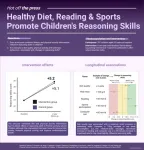(Press-News.org) PHILADELPHIA – Patients with pancreatic cancer who took the benzodiazepine lorazepam (Ativan), commonly prescribed to treat anxiety during cancer treatment, had a shorter progression-free survival than patients who did not, according to results published in Clinical Cancer Research, a journal of the American Association for Cancer Research (AACR).
In contrast, patients who took the benzodiazepine alprazolam (Xanax) had a significantly longer progression-free survival than patients who did not.
Benzodiazepines are a class of drugs that suppress the activity of the central nervous system, which can relieve symptoms of anxiety, insomnia, and seizures. Cancer patients are frequently prescribed benzodiazepines to help with such issues resulting from their disease or treatment. However, there is little comprehensive research about how benzodiazepine use may affect cancer outcomes, said Michael Feigin, PhD, an associate professor of pharmacology and therapeutics at Roswell Park Comprehensive Cancer Center and senior author of the study.
“When we study response to therapy, we think of treatments like chemotherapy or immunotherapy, but patients are also given a lot of medicines for anxiety and pain,” Feigin said. “We wanted to understand the impact of some of these palliative care drugs on the tumor.”
Feigin and colleagues first evaluated how many patients take benzodiazepines during cancer treatment. Among patients treated at Roswell Park for prostate, pancreatic, ovarian, kidney, head and neck, endometrial, colon, breast, or brain cancer or melanoma, 30.9% had received benzodiazepines; patients with pancreatic cancer had the highest rate of benzodiazepine use at 40.6%.
The researchers then examined the relationship between benzodiazepine use and survival in patients with pancreatic cancer. When they adjusted for age, race, sex, disease stage and progression, and treatments received, any benzodiazepine use was associated with a 30% lower risk of pancreatic cancer-related death.
However, when Feigin and colleagues studied the relationship between individual benzodiazepines and pancreatic cancer outcomes, they found stark differences. Apart from short-acting benzodiazepines used as part of surgical anesthesia, the two most commonly used benzodiazepines were lorazepam (40 patients) and alprazolam (27 patients). Patients who took alprazolam had a 62% lower risk of disease progression or death compared with those who did not take alprazolam (42 patients). Conversely, patients taking lorazepam had a 3.83-fold higher risk of disease progression or death than patients who did not take lorazepam (29 patients).
When the researchers investigated the associations between lorazepam and alprazolam use and patient outcomes in other cancer types, they found that alprazolam was rarely associated with significantly different outcomes. However, lorazepam use correlated with significantly worse overall survival in prostate, ovarian, head and neck, uterine, colon, and breast cancer, as well as melanoma, with effects ranging from a 25% increased risk to a 116% increased risk.
Feigin and colleagues investigated why. “Some prior studies examined the effect of benzodiazepines on tumor cell growth using models without a microenvironment,” Feigin said. “Since the tumor microenvironment plays a big role in pancreatic cancer biology, we wanted to know what the benzodiazepines are doing to the microenvironment.”
Abigail Cornwell, first author of the study and a graduate student in Feigin’s lab, led mechanistic studies showing that lorazepam may activate a protein called GPR68, which is highly expressed on fibroblasts that support the tumor. GPR68 boosts expression of the cytokine IL-6, which promotes inflammation in the pancreatic tumor microenvironment, leading to increased tumor growth.
However, only one class of benzodiazepines, called n-unsubstituted benzodiazepines (including lorazepam, clonazepam, nordiazepam, and oxazepam), could activate GPR68. N-substituted benzodiazepines (including alprazolam, diazepam, and temazepam) had no effect on GPR68 activation.
“We think the mechanism comes down to a difference in structure between different benzodiazepines,” Feigin said. “Alprazolam has the opposite effect as lorazepam; it has no impact on GPR68, but it potently decreases IL-6, and we think this decreases the inflammatory potential of these tumors.”
“I think it’s too early to say patients should stop taking one drug or start taking another drug,” Feigin said, clarifying that this was a correlative analysis. “There’s a lot more to learn in terms of the clinical implications.”
Feigin said the next step would be a clinical trial to prospectively evaluate the effects of lorazepam and alprazolam on pancreatic cancer outcomes and the human pancreatic cancer microenvironment.
Limitations of this study include differences in optimal benzodiazepine dosing between mice and humans, as well as differences in benzodiazepine doses given to human patients for different indications, which was not accounted for in this study. Further, some of the mouse experiments were performed on subcutaneously implanted tumors which have a different microenvironment than tumors that develop in the pancreas.
This study was funded by the National Cancer Institute of the National Institutes of Health, the Roswell Park Alliance Foundation, and the Fifth District AHEPA Cancer Research Foundation Inc. Feigin declares no conflicts of interest.
END
Lorazepam treatment may be linked to worse outcomes for pancreatic cancer patients
2023-08-17
ELSE PRESS RELEASES FROM THIS DATE:
A healthy diet, reading, and doing sports promote reasoning skills in children
2023-08-17
Reasoning skills are crucial skills in learning, academic performance, and everyday problem-solving. According to a recent study conducted at the University of Eastern Finland, improved overall diet quality and reduced consumption of red meat, as well as increased time spent in reading and organised sports enhanced reasoning skills among children over the first two school years.
“Children with healthier eating habits showed greater cognitive development than other children. Specifically, better overall diet quality, ...
Heredity and environment account for people’s love of nature
2023-08-17
Humans have a positive view of nature. But is this due to an approach we have learned while growing up, or is it something we are born with? The answer is ‘Both’, according to researchers at the University of Gothenburg and the Swedish University of Agricultural Sciences.
Our love of nature is highly individual and should influence how we plan our cities, say the researchers.
It is well known that nature has a positive effect on people. In cities in particular, studies have shown that trees and other greenery contribute to people’s wellbeing. However, experts do not agree on the reasons behind this phenomenon, known ...
Are you breaking your body clock?
2023-08-17
Researchers are using mathematical models to better understand the effects of disruptions like daylight savings time, working night shifts, jet lag or even late-night phone scrolling on the body’s circadian rhythms.
The University of Waterloo and the University of Oxford researchers have developed a new model to help scientists better understand the resilience of the brain’s master clock: the cluster of neurons in the brain that coordinates the body’s other internal rhythms. They also hope to suggest ...
HKUMed & CityU researchers jointly generate human neural stem cells with powerful therapeutic potential for the treatment of spinal cord injury, paving the way for new therapeutic opportunities
2023-08-17
A joint research team from LKS Faculty of Medicine, the University of Hong Kong (HKUMed) and City University of Hong Kong (CityU) has generated human neural stem cells with powerful therapeutic potential for the treatment of spinal cord injury that paves the way for new therapeutic opportunities. The new findings are now published in the leading multidisciplinary science journal, Advanced Science [link to publication].
Background
Traumatic spinal cord injury (SCI) commonly caused by a car accident, fall, or sport-related accident results in the progressive loss of neurons involved in motor and sensory functions at and around ...
Nauseous territory: outfoxing predators using baits that make them barf
2023-08-17
Introduced foxes, dogs, cats, rats, and other predators kill millions of native animals every year, but what if they were conditioned to associate this prey with food that made them ill?
A team of international researchers have shown the potential to do just that, burying baits containing capsules of levamisole, a chemical that induces nausea and vomiting when consumed by predators.
In a world first experiment conducted in south-eastern Australia, where introduced red foxes are responsible for countless wildlife deaths, the Australian National University (ANU) and University of South Australia scientists laid baits of fried deboned chicken, with some containing ...
Accelerating discovery in artificial intelligence for science
2023-08-17
What if artificial intelligence (AI) could be used to spur discovery in areas such as biotechnology, drug discovery and fluid dynamics? Using geometric graphs and innovative methodologies, AI can solve fundamental problems in basic natural science. The possibilities are endless in this relatively new field known as AI for science.
Dr. Shuiwang Ji, a professor in the Department of Computer Science and Engineering at Texas A&M University, recently received a National Science Foundation grant to ...
Sylvester Surgeon-scientist awarded center’s first Department of Defense grant to study pancreatic cancer
2023-08-17
MIAMI, FLORIDA (Aug. 17, 2023) – Researchers with Sylvester Comprehensive Cancer Center at the University of Miami Miller School of Medicine have been awarded a grant from the U.S. Department of Defense (DoD)’s Congressionally Directed Medical Research Program to target chemotherapy resistance in pancreatic cancer.
The $800,000, three-year grant is the first DoD award to Sylvester to study pancreatic cancer, a disease characterized by extreme resistance to chemotherapy and other treatments and dismal survival rates.
Pancreatic ductal adenocarcinoma is the most common and aggressive ...
Novel treatment based on gene editing safely and effectively removes HIV-like virus from genomes of non-human primates
2023-08-17
(Philadelphia, PA) – A single injection of a novel CRISPR gene-editing treatment safely and efficiently removes SIV – a virus related to the AIDS-causing agent HIV – from the genomes of non-human primates, scientists at the Lewis Katz School of Medicine at Temple University now report. The groundbreaking work complements previous experiments as the basis for the first-ever clinical trial of an HIV gene-editing technology in human patients, which was authorized by the Food and Drug Administration (FDA) in 2022.
The preclinical study, published online ...
Urban great tits have paler plumage than their forest-living relatives
2023-08-17
As urban areas expand, animals increasingly find themselves living in towns and cities. While some animals may benefit from milder temperatures and fewer natural predators in urban settings, they also have to cope with pollutants and changes in their diet. Previous research has shown that animals in cities are “duller” in terms of yellow-orange-red colour tones compared to their non-urban counterparts. However, previous studies have only focused on single geographic locations.
“We used feather samples collected from great tits in cities and forests across Europe. Different methods all confirmed that urban great tits ...
Our plastic waste can be used as raw material for detergents, thanks to an improved catalytic method
2023-08-17
(Santa Barbara, Calif.) — We’ve managed to accumulate so much plastic trash that it’s daunting to think about what could be done with the tons upon tons of nonbiodegradable waste. And as much as we are trying to scale back our dependence on single-use plastics, we continue to add to the global plastic trash hoard. Events like the COVID-19 pandemic only served to expand their use for personal protective equipment and disposable and take-away packaging.
But, for researchers at UC Santa Barbara, one person’s single-use packaging ...





